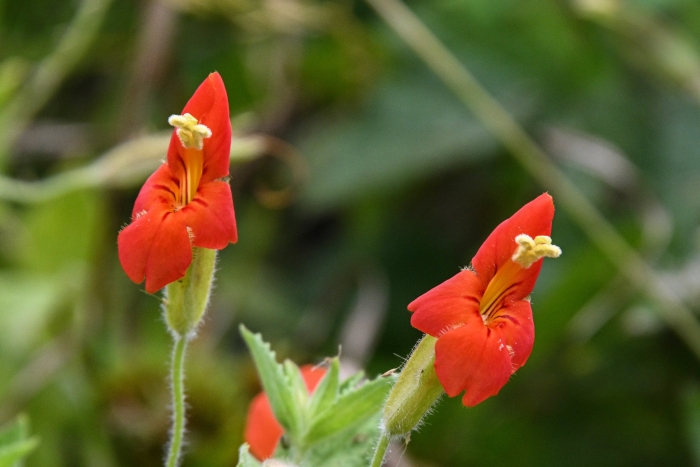Scarlet Monkeyflower
(Erythranthe cardinalis)
Scarlet Monkeyflower (Erythranthe cardinalis)
/
/

Karen and Mike
CC BY 4.0
Image By:
Karen and Mike
Recorded By:
Copyright:
CC BY 4.0
Copyright Notice:
Photo by: Karen and Mike | License Type: CC BY 4.0 | License URL: http://creativecommons.org/licenses/by/4.0/ | Rights Holder: Karen and Mike | Publisher: iNaturalist | Date Created: 2020-07-15T10:52:56-07:00 |



















































Estimated Native Range
Summary
Erythranthe cardinalis, commonly known as Scarlet Monkeyflower, is a perennial herb that can be evergreen or deciduous depending on the climate. It is native to riparian zones, wet meadows, and moist forested areas of California and Baja California, Mexico. The plant typically grows to a height of 2 feet (0.6 meters) and can spread to a width of 4 feet (1.2 meters). Scarlet Monkeyflower has a bushy habit with upright stems and features tubular red or orange-red flowers, occasionally yellow, that bloom prolifically from late spring through summer and into fall. The flowers are particularly showy and are adapted for pollination by hummingbirds, which are attracted to the nectar-rich blooms. The foliage consists of toothed, downy leaves that add to the plant’s texture.
Scarlet Monkeyflower is valued for its vibrant flowers and ability to attract wildlife, making it a popular choice for naturalistic gardens, native plant landscapes, and sustainable municipal projects. It thrives in wet, poorly-drained soils and prefers full sun, although it can tolerate part shade. While it is adaptable to a range of soil types, it does best in a sheltered location. Due to its preference for moist conditions, it is not drought-tolerant and requires consistent moisture. Cultivars such as "Santa Cruz Island Gold" offer a variety of flower colors. Despite its beauty, it can be short-lived and is sometimes grown as an annual in colder regions.CC BY-SA 4.0
Scarlet Monkeyflower is valued for its vibrant flowers and ability to attract wildlife, making it a popular choice for naturalistic gardens, native plant landscapes, and sustainable municipal projects. It thrives in wet, poorly-drained soils and prefers full sun, although it can tolerate part shade. While it is adaptable to a range of soil types, it does best in a sheltered location. Due to its preference for moist conditions, it is not drought-tolerant and requires consistent moisture. Cultivars such as "Santa Cruz Island Gold" offer a variety of flower colors. Despite its beauty, it can be short-lived and is sometimes grown as an annual in colder regions.CC BY-SA 4.0
Plant Description
- Plant Type: Herb
- Height: 1-3 feet
- Width: 1-4 feet
- Growth Rate: Moderate
- Flower Color: Red
- Flowering Season: Spring, Summer, Fall
- Leaf Retention: Semi-deciduous
Growth Requirements
- Sun: Part Shade
- Water: High
- Drainage: Medium
Common Uses
Bee Garden, Bird Garden, Border Plant, Butterfly Garden, Deer Resistant, Erosion Control, Hummingbird Garden, Low Maintenance, Rabbit Resistant, Rock Garden, Showy Flowers, Water Garden
Natural Habitat
Native to riparian zones, wet meadows, and moist forested areas of California and Baja California, Mexico
Other Names
Common Names: Cardinal Monkey-Flower
Scientific Names: Mimulus cardinalis , Erythranthe cardinalis , Mimulus cardinalis var. rigens , Mimulus cardinalis var. exsul , Mimulus cardinalis var. griseus , Diplacus cardinalis , Mimulus cardinalis var. cardinalis , Mimulus maclaineanus , Mimulus maclainii
GBIF Accepted Name: Erythranthe cardinalis (Douglas ex Benth.) Spach